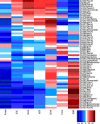Allochthonous carbon is a major regulator to bacterial growth and community composition in subarctic freshwaters
- PMID: 27686416
- PMCID: PMC5043279
- DOI: 10.1038/srep34456
Allochthonous carbon is a major regulator to bacterial growth and community composition in subarctic freshwaters
Abstract
In the subarctic region, climate warming and permafrost thaw are leading to emergence of ponds and to an increase in mobility of catchment carbon. As carbon of terrestrial origin is increasing in subarctic freshwaters the resource pool supporting their microbial communities and metabolism is changing, with consequences to overall aquatic productivity. By sampling different subarctic water bodies for a one complete year we show how terrestrial and algal carbon compounds vary in a range of freshwaters and how differential organic carbon quality is linked to bacterial metabolism and community composition. We show that terrestrial drainage and associated nutrients supported higher bacterial growth in ponds and river mouths that were influenced by fresh terrestrial carbon than in large lakes with carbon from algal production. Bacterial diversity, however, was lower at sites influenced by terrestrial carbon inputs. Bacterial community composition was highly variable among different water bodies and especially influenced by concentrations of dissolved organic carbon (DOC), fulvic acids, proteins and nutrients. Furthermore, a distinct preference was found for terrestrial vs. algal carbon among certain bacterial tribes. The results highlight the contribution of the numerous ponds to cycling of terrestrial carbon in the changing subarctic and arctic regions.
Figures



References
-
- Tranvik L. J. et al. Lakes and reservoirs as regulators of carbon cycling and climate. Limnol. Oceanogr. 54, 2298–2314 (2009).
-
- Guillemette F., Mccallister S. L. & del Giorgio P. A. Differentiating the degradation dynamics of algal and terrestrial carbon within complex natural dissolved organic carbon in temperate lakes. J. Geophys. Res. Biogeosci. 118, 963–973 (2013).
-
- Seekell D. A. et al. The influence of dissolved organic carbon on primary production in northern lakes. Limnol. Oceanogr. 60, 1276–1285 (2015).
-
- Ask J. et al. Terrestrial organic matter and light penetration: Effects on bacterial and primary production in lakes. Limnol. Oceanogr. 54, 2034–2040 (2009).
-
- Abnizova A., Siemens J., Langer M. & Boike J. Small ponds with major impact: the relevance of ponds and lakes in permafrost landscapes to carbon dioxide emissions. Global Biogeochem. Cy. 26, GB2041 (2012).
LinkOut - more resources
Full Text Sources
Other Literature Sources
Research Materials

